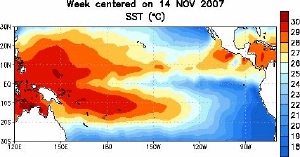Feb 11 2008
The current La Niña event, characterized by a cooling of the sea surface in the central and eastern Equatorial Pacific, has strengthened slightly in recent months and is expected to continue through the first quarter of 2008, with a likelihood of persisting through to the middle of the year.

The ongoing La Niña event started in the third quarter of 2007 and has already influenced climate patterns during the last six months across many parts of the globe, including in the Equatorial Pacific, across the Indian Ocean, Asia, Africa and the Americas.
During the last three months, La Niña conditions have become slightly stronger. Sea surface temperatures are now about 1.5 to 2 degrees Celsius colder than average over large parts of the central and eastern Equatorial Pacific. This La Niña is in the mid range of past historically recorded events, but the slight further cooling in recent months will likely place it on the stronger side of the middle range.
During a La Niña event, sea surface temperatures in the central and eastern Equatorial Pacific become cooler than normal. Such cooling has important effects on the global weather, particularly rainfall. While sea surface temperatures cool in the central and eastern Equatorial Pacific, those in the west remain warmer. This is associated with increases in the frequency of heavy rain and thunderstorms in surrounding regions.
In contrast to La Niña, the El Niño phenomenon is characterized by substantially warmer than average sea surface temperatures in the central and eastern Equatorial Pacific.
These temperature changes in the Equatorial Pacific related to La Niña and El Niño are strongly linked to major global climate fluctuations and, once initiated, can last for 12 months or more.
Most interpretations of existing climatological data suggest the likelihood of La Niña conditions remaining heightened through the second quarter of 2008 and, at a lower level of confidence, into the first part of the third quarter.
Longer seasonal forecasts beyond the third quarter of 2008 are not considered to contain useful information at this stage on the continuation of La Niña or the rise of El Niño.
It is rare for a La Niña event to persist for two years or more, such as occurred from early 1998 to early 2000. The likelihood of the current La Niña continuing for such a period will remain unclear for some months, but will be closely monitored. Long-term statistics suggest it is more likely that in the latter part of 2008, neutral conditions will prevail, i.e., neither La Niña nor El Niño with no significant cooling or warming of Equatorial Pacific sea surface temperatures.